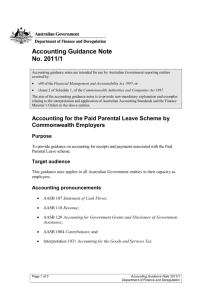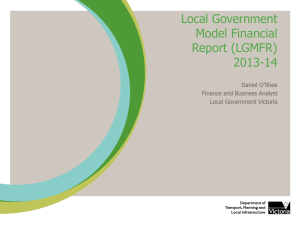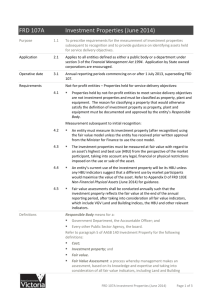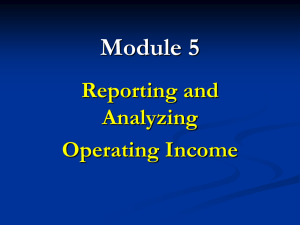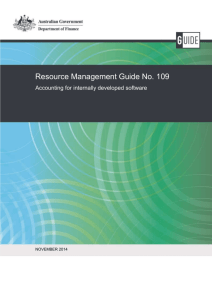Accounting For Income Tax - Australian Accounting Standards Board
advertisement
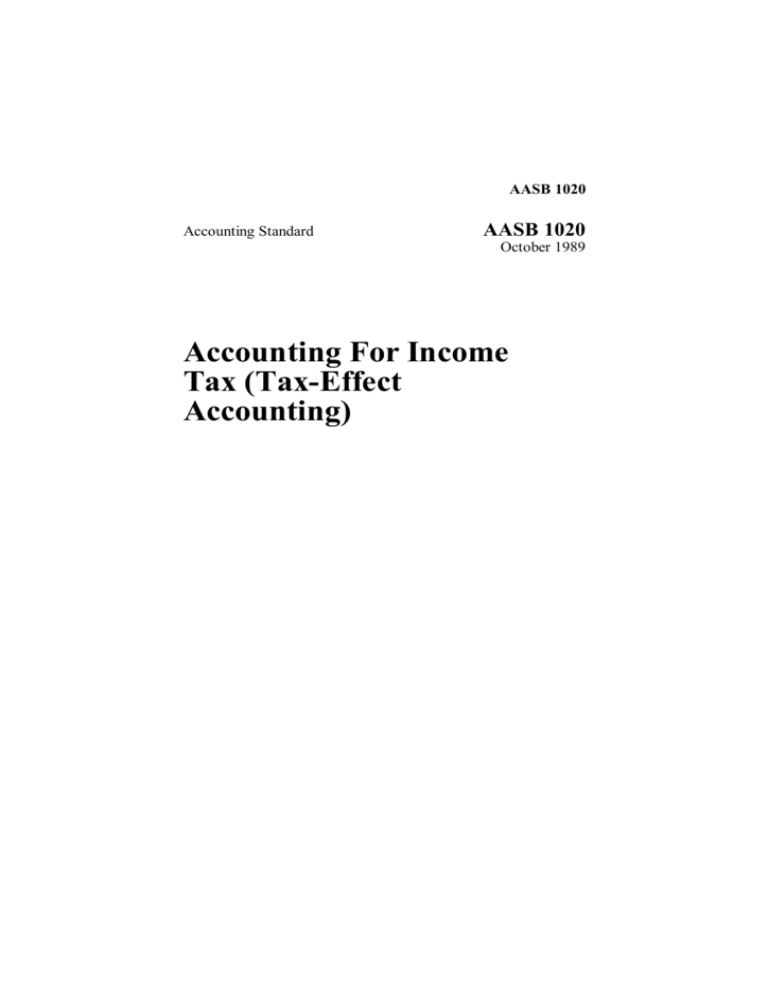
AASB 1020 Accounting Standard AASB 1020 October 1989 Accounting For Income Tax (Tax-Effect Accounting) AASB 1020 CONTENTS Starting at Clause: Citation ........................................................................................... 1020.00 Endorsed Explanatory Material ....................................................... 1020.01 Application ..................................................................................... 1020.02 Statement of Purpose ....................................................................... 1020.03 Interpretation .................................................................................. 1020.04 Application of Materiality: Accounting for Income Tax ................................................................................... 1020.05 Definitions ...................................................................................... 1020.06 Determination of Income Tax Expense, Provision for Deferred Income Tax and Future Income Tax Benefit ............................................................ 1020.10 Group Accounts............................................................................... 1020.20 Taxes on Distribution of Profits and Reserves.................................. 1020.30 Changes in Income Tax Rates ......................................................... 1020.40 Transitional Provision ..................................................................... 1020.50 COMMENTARY Citation .00 This standard, with the exception of the words shown in italics, may be cited as Accounting Standard AASB 1020: Accounting for Income Tax (Tax-effect Accounting). [Amended by AASB 1025, para. 8] Endorsed Explanatory Material .01 The accounting standards set out in this standard are shown in normal print. The endorsed explanatory material is printed in italics. Explanatory material is set out in two ways: (a) immediately after certain of the requirements; and (b) as a commentary at the end of the standard. Application .02 This standard applies to each company in relation to its first financial period that ends on or after 31 December 1989, and in relation to subsequent financial periods of the company. AASB 1020 Notice of approval of this standard was published in the Commonwealth of Australia Gazette on 30 October 1989. In all cases, compliance with a requirement of a standard is subject to any relevant provision of the Code. .02A Notwithstanding anything in clause .02, this standard applies to each company in relation to its financial years that end on or after 30 June 1992 only where the company is a reporting entity. [Inserted by AASB 1025, para. 11] .02B Notwithstanding anything in clause .02, this standard also applies to each company which is the parent entity in an economic entity in relation to its financial years that end on or after 30 June 1992 only where the economic entity is a reporting entity. [Inserted by AASB 1025, para. 11] .02C A company or economic entity which is not a reporting entity shall, when it prepares a financial report which is purported to be a general purpose financial report, apply this standard as if it is a reporting entity. [Inserted by AASB 1025, para. 11] Statement of Purpose .03 The purpose of this standard is: (a) to specify the method for determining income tax expense, provision for income tax, provision for deferred income tax and future income tax benefit; and (b) to require disclosure in the accounts and group accounts of information in relation to income tax expense, provision for income tax, provision for deferred income tax and future income tax benefit; so that users entitled to rely on the accounts or group accounts are provided with information on the impact of tax on the income of companies under provisions of the Australian Income Tax Assessment Act 1936 (and of any applicable foreign tax legislation) which is necessary for an understanding of the financial position, performance, and financing and investing of the company or group of companies. Interpretation AASB 1020 .04 (1) This standard is to be interpreted in accordance with the Corporations Law, including Parts 1.2 and 3.6. The endorsed explanatory material contained in this standard can be used, subject to section 109J of the Corporations Law, as an aid to interpreting the accounting standards contained in this standard. (2) Except for a citation of a replaced or superseded standard in an application clause, any reference in this standard to a standard approved by the Accounting Standards Review Board shall be taken to include the standard as subsequently amended or replaced by a standard made by the Australian Accounting Standards Board as it applies to the financial year for which the accounts and group accounts are being prepared. [Substituted by AASB 1025, para. 17] For example, a reference to Approved Accounting Standard ASRB 1001: Accounting Policies - Disclosure would include, in relation to financial years that end on or after 30 June 1992, a reference to Accounting Standard AASB 1001: Accounting Policies Disclosure. [Inserted by AASB 1025, para. 18] Application of Materiality: Accounting for Income Tax .05 The accounting standards set out in this standard shall apply to accounts and group accounts where such application is of material consequence. Information relating to the subject matter of this standard is material if its omission, non-disclosure or misstatement has the potential to adversely affect: (a) decisions about the allocation of scarce resources made by users of the accounts or group accounts; or (b) the discharge of accountability by directors. [Substituted by AASB 1025, para. 23] In deciding whether an item is material, its nature and amount usually need to be evaluated together. [Inserted by AASB 1025, para. 24] Definitions .06 In this standard unless the contrary intention appears: "brought to account" means recognised in the accounts or group accounts, otherwise than by way of note; AASB 1020 "Code" means, where this standard applies in (a) the Australian Capital Territory - the Companies Act 1981, and the regulations made under that Act; or (b) a State or the Northern Territory - the Companies Code of a State or the Northern Territory, as defined in the Companies (Application of Laws) Act of that State or the Northern Territory and the regulations applying under that Code; "economic entity" means a group of entities comprising the parent entity and each of its subsidiaries; [Inserted by AASB 1025, para. 27] "entity" means any legal, administrative, or fiduciary arrangement, organisational structure or other party (including a person) having the capacity to deploy scarce resources in order to achieve objectives; [Inserted by AASB 1025, para. 27] "financial period" means, in relation to (a) accounts of a corporation referred to in paragraph 158(5)(b) of the Code or, where that corporation is a holding company, the group accounts prepared in accordance with that paragraph - the period of six months after the end of the financial year of that corporation; (b) a set of consolidated accounts of a borrowing corporation and each guarantor corporation referred to in paragraph 158(6)(b) of the Code - the period of six months after the end of the financial year of the borrowing corporation; or (c) the accounts or group accounts of any other corporation the financial year of the corporation; "financial report" means accounts or group accounts or both; [Inserted by AASB 1025, para. 27] "future income tax benefit" means the estimated amount of future saving in income tax likely to arise as a result of: (a) the reversal of timing differences; and AASB 1020 (b) the recoupment of carried forward tax losses (which for the purposes of this standard are dealt with separately from other timing differences); "general purpose financial report" means a financial report intended to meet the information needs common to users who are unable to command the preparation of reports tailored so as to satisfy, specifically, all of their information needs; [Inserted by AASB 1025, para. 27] "group accounts" means, in relation to fiancial years ending on or after 31 December 1991, consolidated accounts; [Inserted by AASB 1025, para. 27] "group of companies" means, in relation to financial years ending on or after 31 December 1991, economic entity; [Inserted by AASB 1025, para. 28] "income tax expense" means the amount of income tax which would be payable on the pre-tax accounting profit adjusted for permanent differences. The term "income tax benefit" is used to describe this amount where it is a net credit; "income tax payable" means the amount of income tax calculated on the taxable income of a company for the financial period; "parent entity" means an entity which controls another entity; [Inserted by AASB 1025, para. 27] "permanent differences" means differences between taxable income or tax loss and pre-tax accounting profit or loss arising from the existence of: (a) particular expenses and particular items of revenue, which, under current income tax legislation, will never be included in the determination of taxable income or tax loss although they are brought to account in the profit and loss account; and (b) particular amounts which are allowable deductions or which are assessable income for income tax purposes although these amounts will never be brought to account in the profit and loss account; "pre-tax accounting profit or loss" means the aggregate of the operating profit or loss and the extraordinary items for a given AASB 1020 financial period before charging the related income tax expense or before crediting the related future income tax benefit; "provision for deferred income tax" means the non-current liability for the estimated amount of income tax expected to be assessed in the future as a result of the reversal of timing differences; "provision for income tax" means the current liability for the estimated amount of income tax which is assessable on the taxable income of the company for the current and prior financial periods (to the extent that such tax has not been already paid); "reporting entity" means an entity (including an economic entity) in respect of which it is reasonable to expect the existence of users dependent on general purpose financial reports for information which will be useful to them for making and evaluating decisions about the allocation of scarce resources, and includes but is not limited to the following: (a) a listed corporation; (b) a borrowing corporation; and (c) a company which is not a subsidiary of a holding company incorporated in Australia and which is a subsidiary of a foreign company where that foreign company has its securities listed for quotation on a stock market or those securities are traded on a stock market; [Inserted by AASB 1025, para. 27] "subsidiary" means, in relation to financial years ending on or after 31 December 1991, an entity which is controlled by a parent entity; [Inserted by AASB 1025, para. 27] "taxable income" means the excess of assessable income over allowable deductions calculated according to the provisions of the applicable income tax legislation ("tax loss" means the converse); and "timing differences" means differences between pre-tax accounting profit or loss and taxable income or tax loss for a given financial period which arise because the financial period in which some items of revenue and expense are included in the determination of the pre-tax accounting profit or loss does not AASB 1020 coincide with the financial period in which they are included in the determination of taxable income or tax loss. Each timing difference originates in one financial period and is reversed, or "turns around", in one or more subsequent financial periods. Relevant provisions of the Code include: Sub-section 266E(1): "Unless the contrary intention appears in the accounting standard, an expression used in an approved accounting standard has the same meaning as the expression has in this Part [Part VI]". Sub-section 5(1): definition of "financial year" and "profit and loss account". Sub-section 7(1): definition of "subsidiary". Sub-section 266(1): definition of "accounts", "group accounts" and "group of companies". Reporting entities: Companies other than the types identified in the definition of "reporting entity" may, in particular circumstances, be reporting entities. Such companies are required to comply with this standard in those circumstances. Paragraphs 19 to 37 of Statement of Accounting Concepts SAC 1 "Definition of the Reporting Entity" provide guidance for determining whether an entity is a reporting entity. [Inserted by AASB 1025, para 29] Determination of Income Tax Expense, Provision for Deferred Income Tax and Future Income Tax Benefit .10 The amount of the income tax expense attributable to the transactions included in the profit and loss account for a financial period shall be brought to account in that profit and loss account irrespective of whether the income tax is currently payable, or has already been paid, or will become payable in the future. The amount of such income tax expense shall be calculated on the pretax accounting profit or loss, adjusted for permanent differences (if any), by using the liability method of tax-effect accounting. Where the permanent differences are material, a note to the accounts and group accounts shall state their general nature and the extent to which they have affected the amount of income tax expense. AASB 1020 .11 If in respect of a financial period the income tax payable differs from the income tax expense, the amount of the difference: (a) shall be brought to account and disclosed as a liability, described as "provision for deferred income tax", to the extent that the difference arises from timing differences caused by the present deductibility for tax purposes of expenses deferred for accounting purposes and/or the present non-assessability for tax purposes of revenue included in the determination of pre-tax accounting profit or loss; and (b) shall, subject to the provisions of clauses .12 and .13, be brought to account and disclosed as an asset, described as "future income tax benefit", to the extent that the difference arises from timing differences caused by the present nondeductibility for tax purposes of expenses included in the determination of the pre-tax accounting profit or loss and/or the current assessability for tax purposes of revenue items deferred for accounting purposes. For endorsed comment on clauses .10 and .11 see: Paragraphs (ii) and (iii): Differences between taxable income or tax loss and pre-tax accounting profit or loss Paragraphs (iv) to (vii): The liability method of tax-effect accounting .12 .13 A future income tax benefit referred to in clause .11 shall only be carried forward as an asset where realisation of the benefit can be regarded as being assured beyond any reasonable doubt. Realisation shall depend upon: (a) the ability of the company to derive future assessable income of a nature and of sufficient amount to enable the benefit to be realised; (b) the ability of the company to continue to comply with the conditions for deductibility imposed by law; and (c) an expectation that legislation will not change in a manner which would adversely affect the company's ability to realise the benefit. In the case of companies which incur losses, any future income tax benefit shall not be brought to account as an asset unless realisation of the benefit is virtually certain. Where any part of a future income tax benefit carried forward as an asset is attributable to tax AASB 1020 losses, that part shall be separately disclosed by way of note in the accounts and group accounts. .14 Where a provision for deferred income tax exists and a company incurs a tax loss, the future income tax benefit attributable to the tax loss shall be brought to account as a reduction of the provision for deferred income tax to the extent that deferred income tax has already been provided in respect of timing differences which will reverse within the financial periods during which the tax loss will remain available as a deduction from assessable income. The amount representing the reduction in the provision shall be shown in the accounts and group accounts by way of note or otherwise and described as "provision for deferred income tax no longer required". The extent to which the provision for deferred income tax is reduced by future income tax benefits attributable to tax losses shall be separately disclosed by way of note in the accounts and group accounts of each financial period while the losses remain available as a deduction. .15 To the extent that a future income tax benefit attributable to tax losses has not been recognised as an asset or as a reduction in a provision for deferred income tax and there is a possibility that the tax losses will be recouped in accordance with tax legislation, the future income tax benefit expected to arise from the recoupment shall be shown by way of a note to the accounts and group accounts. The note shall state that the benefit will only be obtained if: .16 (a) the company derives future assessable income of a nature and of an amount sufficient to enable the benefit from the deductions for the loss to be realised; (b) the company continues to comply with the conditions for deductibility imposed by tax legislation; and (c) no changes in tax legislation adversely affect the company in realising the benefit from the deductions for the loss. In any financial period in which past income tax losses are recouped, the income tax expense for that financial period, determined in accordance with clause .10 above, shall be brought to account in the profit and loss account in the normal way, and (a) to the extent that the future income tax benefit attributable to such losses has not been brought to account (or if it had been brought to account and subsequently reversed) - the tax benefit derived from the recoupment of those losses shall be included in the profit and loss account; AASB 1020 .17 (b) if a future income tax benefit had been previously brought to account in relation to tax losses - that future income tax benefit shall be reduced by the amount of the realised tax benefit; or (c) if a provision for deferred income tax had been previously reduced or eliminated - the excess of the income tax expense (less the amounts, if any, already dealt with under paragraphs (a) and (b) above) over the income tax currently payable shall be added to the provision for deferred income tax so that when the past tax losses are recouped and income tax becomes payable the provision will be sufficient to cover the income tax which becomes payable as the related timing differences reverse. Where differences arise between the amount of the income tax payable in respect of a financial period and the income tax expense for the same financial period, and some or all of the differences arise because of reversals of timing differences brought to account in prior financial periods, the differences attributable to such reversals shall be adjusted against the balance shown in the future income tax benefit account, or provision for deferred income tax account. At each balance date a transfer shall be made from the provision for deferred income tax to the provision for income tax of any portion of the first-mentioned provision which has become a current liability as a result of the reversal of timing differences. For endorsed comment on clauses .12 to .17 see: Paragraphs (viii) to (xii): Future income tax benefits .18 Except in the case of group accounts, a provision for deferred income tax shall be offset against future income tax benefit brought to account, to the extent that income tax covered by the provision is likely to become payable in the same financial periods as the future income tax benefit is expected to become realisable. Group Accounts .20 A future income tax benefit brought to account by one company in a group of companies shall not be offset against a provision for deferred income tax brought to account by another company in the group of companies, when drawing up group accounts. Taxes on Distribution of Profits and Reserves .30 Where accounts or group accounts include profits and reserves of branch operations or subsidiaries which, on distribution to the AASB 1020 company or holding company, will be subject to overseas withholding tax or to further Australian income tax, the reduction which this future tax will impose on the amount ultimately available to the company or holding company shall be brought to account as provision for deferred income tax in the accounts or group accounts unless there is evidence that the company or holding company intends to leave those profits and reserves indefinitely in the hands of the branch operations or subsidiaries. Changes in Income Tax Rates .40 Whenever there is a change in the income tax rate, either or both of the provision for deferred income tax and the future income tax benefit brought forward from the previous financial period shall be adjusted accordingly. If the adjustment is material, the corresponding amount brought to account in the profit and loss account shall be disclosed. Transitional Provision .50 Where the accounting policies required by this standard are not already being applied as at the beginning of the financial year to which this standard is first applied, they shall be applied as at that date. Where this gives rise to initial adjustments, the net amount of those adjustments shall, in accordance with Accounting Standard AASB 1018: Profit and Loss Accounts, be adjusted against retained profits or accumulated losses as at the beginning of the financial year to which this standard is first applied. [Substituted by AASB 1025, para. 35] COMMENTARY Differences between taxable income or tax loss and pre-tax accounting profit or loss (i) Under Australian income tax legislation, the amount of tax levied against a company is based upon its taxable income or tax loss which will often differ in amount from its pre-tax accounting profit or loss because of permanent and timing differences. (a) Permanent differences (ii) Permanent differences alter the incidence of income tax in relation to the pre-tax accounting profit or loss of the financial period in AASB 1020 which they occur, but do not affect income tax calculations in respect of subsequent financial periods. An example of an item creating a permanent difference under present income tax legislation is non-allowable depreciation on buildings. (b) Timing differences (iii) Timing differences will result in the amount of income tax expense being either greater or less than the income tax payable for the financial periods in which the differences originate and then reverse. Four sets of circumstances give rise to timing differences: (a) items of revenue included in the determination of pre-tax accounting profit or loss before they are included in taxable income or tax loss, for example, gross profits on instalment sales brought to account for accounting purposes in the financial period of sale but assessable for tax purposes in the financial periods during which the instalments are collected; (b) expenses deducted in determining taxable income or tax loss before they are deducted in the determination of pretax accounting profit or loss, for example, research and development costs deducted for tax purposes as incurred but carried forward in the accounts to be charged against future revenue; (c) items of revenue included in taxable income or tax loss before they are included in the determination of pre-tax accounting profit or loss, for example, rents or insurance premiums collected in advance and reported for tax purposes in the financial period in which they are received but deferred for accounting purposes until later financial periods when they are recognised as being earned; and (d) expenses deducted in the determination of pre-tax accounting profit or loss before they are deducted in the determination of taxable income or tax loss, for example, provisions for guarantees and product warranties, or provision for long service leave made for accounting purposes on an estimated basis in the financial period in which the related revenue is brought to account, but only allowed for tax purposes in later financial periods when payment is made or when the liability becomes certain. The liability method of tax-effect accounting AASB 1020 (iv) The liability method (sometimes referred to as the accrual method) is based on the assumption that a provision for deferred income tax arises whenever: (a) an item of revenue is recognised in the determination of pre-tax accounting profit or loss before it is included in taxable income or tax loss; or (b) an expense is deducted in calculating taxable income or tax loss before it is recognised in the determination of pretax accounting profit or loss; and conversely, that an asset in the nature of a future income tax benefit arises whenever: (c) an item of revenue is included in taxable income or tax loss before it is recognised in the determination of pre-tax accounting profit or loss; or (d) an expense is recognised in the determination of pre-tax accounting profit or loss before it is deducted in calculating taxable income or tax loss. (v) The estimated amounts of this liability and this asset are determined by calculating the difference between income tax expense and income tax payable, using the tax rate or rates that are expected to apply when the underlying timing differences reverse. The estimates are later amended if the expected tax rates change or new taxes are imposed. (vi) The adoption of the liability method thus results in income tax expense being accrued in the same way as any other expense. Where timing differences have the effect of postponing the payment of tax, the liability method results in both the matching of expense with revenue and the bringing to account of the liability for income taxes payable in the future. Timing differences which result in the prepayment of income tax are also brought to account as assets in order to avoid overstating expenses in the financial periods in which the timing differences originate, and understating expenses in the financial periods in which these differences reverse. (vii) Accounts and group accounts prepared using the liability method of tax-effect accounting will at all times show any provision for deferred income tax and any future income tax benefit at the tax rates that, at the time the accounts and group accounts are prepared, are expected to apply when the underlying timing differences reverse. On this basis, provision for deferred income AASB 1020 tax and future income tax benefits are generally measured using the current rate of income tax. However, when it is known that a different rate of tax will apply by the time particular timing differences are expected to reverse, the relevant provision for deferred income tax and future income tax benefits are measured using that different rate. An announcement by the Federal Treasurer of the Government's intention to change the rate of income tax to another specified rate is normally accepted as adequate evidence that a change to that rate will occur. Future income tax benefits (viii) Tax-effect accounting procedures can be expected to give rise to provision for deferred income tax in respect of timing differences and future income tax benefits in respect of both timing differences and tax losses. Whilst there would appear to be no reason to question the bringing to account of provision for deferred income tax attributable to timing differences and the carrying forward of such a provision under tax-effect accounting procedures, it would appear to be necessary and appropriate to examine the asset which arises on the application of tax-effect accounting procedures to determine whether or not in all cases it is appropriate to carry forward such an asset to future financial periods. (ix) Accounting principles normally require a write-down of assets where they are not expected to realise their carrying amounts. In accordance with these principles, future income tax benefits carried forward as assets are examined to determine whether realisation of the related benefit is assured beyond any reasonable doubt. In considering this matter it should be noted that realisation will take the form of a charge against future pre-tax accounting profit or loss and therefore the ability of a company to earn adequate profits and taxable income in future financial periods must be assured beyond any reasonable doubt if future income tax benefits are to be brought to account as assets. A determination as to the ability of a company to earn a sufficient level of profits in future financial periods will be influenced by whether or not a company has a history of profitable operations and is currently profitable. (x) Where a company incurs a tax loss, significant doubts must arise as to the ability of such a company to realise the related future income tax benefit and in these circumstances it is considered that it would be imprudent to bring to account as an asset the future income tax benefit attributable to the tax loss unless realisation of the benefit is virtually certain. It is considered that this test of virtual certainty will only be met in rare and exceptional cases. However, AASB 1020 where a company incurs a tax loss, realisation of the future income tax benefit can, to some extent, be regarded as virtually certain where there is already in existence as a liability, a provision for deferred income tax. The extent to which realisation can be regarded as virtually certain is the extent to which deferred income tax has already been provided in respect of timing differences which will reverse in the financial periods during which the tax loss will remain available as a deduction. In these circumstances, when a loss is incurred, the benefit of the tax loss arising therefrom can be treated as effectively realised (and can be brought to account in the form of a reduction in the provision for deferred income tax) on the basis that the tax provided as a cover against the future reversal of timing differences will not become payable whilst the tax loss remains unrecouped and available as a deduction from future assessable income. (xi) Since it is not appropriate to draw a distinction between: (a) the ability of a company which incurs a loss to realise the future income tax benefit attributable to the loss; and (b) the ability of such a company to realise a future income tax benefit attributable to timing differences; it would be appropriate in the case of such a company to apply the same test of virtual certainty as to realisation in determining whether the company should bring to account as an asset any future income tax benefit, whether the benefit is attributable to current or past timing differences or to tax losses. (xii) Where a company which incurs a tax loss has either not brought to account a future income tax benefit attributable to that loss or has written off future income tax benefits brought forward in relation to timing differences, there would be no reason to preclude such a company from recording such benefits as assets in a later financial period should it return to profitable operations and meet the requirement as to virtual certainty of realisation. Revaluations and disposals of depreciable assets (xiii) Where a revaluation of an asset which is depreciable for income tax purposes has resulted in an increase in the amount at which that asset is carried in the accounts and group accounts, this increase is depreciated over the remaining useful life of the asset. As the additional depreciation charge is not an allowable deduction for income tax purposes, the revaluation results in a permanent difference in subsequent financial periods between pre- AASB 1020 tax accounting profit or loss and taxable income or tax loss which is taken into account in determining the amount of income tax expense. (xiv) Where the amount received on the disposal of a depreciable asset exceeds its depreciated value, a liability for income tax may arise in respect of all or part of the excess. Where an election is made under sub-section 59(2A) of the Income Tax Assessment Act 1936 to reduce the cost, for the purpose of calculating depreciation allowable under this Act, of other units of property by the assessable portion of the excess, that amount is treated as a timing difference. Interim accounts and group accounts (xv) The calculation of the income tax expense to be shown in interim accounts and group accounts is based on the tax rate expected to be applicable for the full financial year, and reflects the incidence of any permanent differences and timing differences which have been caused by transactions or events during the period covered by the interim accounts and group accounts.
